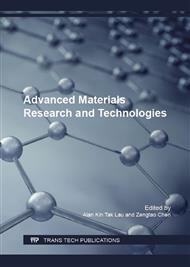[1]
R.S. Pawadea, Suhas S. Joshia, P.K. Brahmankar. Effect of machining parameters and cutting edge geometry on surfaceintegrity of high-speed turned Inconel 718[J]. International Journal of Machine Tools & Manufacture. 48 (2008) 15–28.
DOI: 10.1016/j.ijmachtools.2007.08.004
Google Scholar
[2]
Wang Bo. Simulation Study on Milling Force and Temperature in High-speed Milling of 7050-T7451 Aluminum Alloy [J]. MACHINE TOOL & HYDRAULICS, 2014(16): 47-49.
Google Scholar
[3]
ZHANG Zhao-yang,CHEN Guo-ding, WANG Tao. Study on the Milling Force and Milling Temperature for End Milling of Aluminum Alloy 7055[J]. Machinery Design & Manufacture, 2014(6): 75-78, 83.
Google Scholar
[4]
Xu Sheng-fu,Chen Hui-xian, Chen Ming, et al. Study on milling force and milling temperature distribution of milling cutter with fir-slot [J]. Modern Manufacturing Engineering. 2015(1): 78-80, 124.
Google Scholar
[5]
LIU Dong, CHEN Wu-yi, et al. Cutting Force and Cutting Temperature of Turning Al-Si Alloy[J]. Nonferrous Metals, 2006(1): 39-41.
Google Scholar
[6]
LONG Zhen-hai, ZHAO Wen-xiang, WANG Xi-bin. Experimental Research on Surface Reinforcement Mechanism Introduced by Coupling Effect of Cutting Forces and Heat[J]. OURNAL OF AERONAUTICAL MATERIALS, 2007(6): 45-49.
Google Scholar
[7]
TANG De-wen, Simulation and experimental study on high speed milling of hardened steel[D]. Guangdong University of Technology, (2009).
Google Scholar
[8]
He Zhen-wei, Quan Yan-ming, Yue You-shu. Study on Cutting Heat in High-Speed Cutting Based on FEM Simulation[J]. Tool Engineering, 2006(3): 60-63.
Google Scholar
[9]
YAN Lan, JIANG Feng, RONG Yi-ming. Grinding Mechanism Based on Single Grain Cutting Simulation[J]. JOURNAL OF MECHANICAL ENGINEERING, 2012(11): 172-182.
DOI: 10.3901/jme.2012.11.172
Google Scholar
[10]
TANG De-wen, QIU Chang-jun. Simulation of high-speed milling process for mould quenched steel[J]. Machinery Design & Manufacture, 2012(12): 13-15.
Google Scholar
[11]
Muñoz-Sánchez, A., Canteli, J. A., Cantero, J. L., & Miguélez, M. H. Numerical analysis of the tool wear effect in the machininginduced residual stresses[J]. Simulation Modelling Practice and Theory, 2010(19): 872-886.
DOI: 10.1016/j.simpat.2010.11.011
Google Scholar
[12]
Mohamed N.A. Nasr, E. -G. Ng, M.A. Elbestawi. A modified time-efficient FE approach for predicting machining-induced residual stresses[J]. Finite Elements in Analysis and Design. 44 (2008) 149 – 161.
DOI: 10.1016/j.finel.2007.11.005
Google Scholar
[13]
K.C. Ee, O.W. Dillon Jr., I.S. Jawahir. Finite element modeling of residual stresses in machining induced by cutting using a tool with finite edge radius[J]. International Journal of Mechanical Sciences: 47 (2005) 1611–1628.
DOI: 10.1016/j.ijmecsci.2005.06.001
Google Scholar


